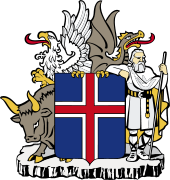- Cod Wars
-
Not to be confused with the Cold War.
The Cod Wars, also called the Icelandic Cod Wars (Icelandic: Þorskastríðin, "the cod war", or Landhelgisstríðin, "the war for the territorial waters"[1]), were a series of confrontations in the 1950s and 1970s between the United Kingdom and Iceland regarding fishing rights in the North Atlantic.
In 1972, Iceland unilaterally declared an Exclusive Economic Zone (EEZ) extending beyond its territorial waters, before announcing plans to reduce overfishing. It policed its quota system with the Icelandic Coast Guard, leading to a series of net-cutting incidents with British trawlers that fished the areas. As a result, the Royal Navy deployed warships and tugboats to act as a deterrent against any future harassment of British fishing crews by the Icelandic craft, resulting in direct confrontations between Icelandic patrol vessels and British warships, which included ramming incidents.
The dispute ended in 1976 after Iceland threatened to close a major NATO base in retaliation for Britain's deployment of naval vessels within the disputed 200 nautical mile (370 km) limit. The British government conceded, and agreed that after 1 December 1976 British vessels would not fish within the previously disputed area.[2]
Contents
Background and history
 Expansion of the Icelandic Exclusive Economic Zone (EEZ).
Expansion of the Icelandic Exclusive Economic Zone (EEZ). Icelandinternal waters4 nmi expansion12 nmi expansion (current extent of territorial waters)50 nmi expansion200 nmi expansion (current extent of EEZ)
Icelandinternal waters4 nmi expansion12 nmi expansion (current extent of territorial waters)50 nmi expansion200 nmi expansion (current extent of EEZ)Iceland's population was at that time[when?] almost exclusively dependent on fishing as a source of income.[citation needed] With increases in fishing ability enabled by steam power in the latter part of the 19th century, pressure was exerted on boat owners and skippers to exploit new grounds. Large catches in Icelandic waters meant voyages across the North Atlantic became more regular. In 1893, the Danish Government, who governed Iceland and the Faroe Islands, claimed a fishing limit of 13 nautical miles (24 km) around their shores. British trawler owners disputed this claim and continued to send their ships to Icelandic waters. Danish gunboats patrolling the area escorted a number of vessels to port, fined them and confiscated their catch.
The British Government did not recognise this claim, on the grounds that setting such a precedent would lead to similar claims by nations which surrounded the North Sea, which would be damaging to the British fishing industry.
In 1896, the United Kingdom made an agreement with Iceland which allowed for British vessels to use any Icelandic port for shelter, provided they stowed their gear and trawl nets. In return, British vessels were not to fish east of a line from Illunypa to Thornodesker Islet.[citation needed]
In April 1899, the steam trawler Caspian was fishing off the Faroe Islands when a Danish gunboat tried to arrest her for allegedly fishing illegally inside the limits. The trawler refused to stop and was fired upon. Eventually the trawler was caught, but before going aboard the Danish vessel, the skipper ordered the Mate to make a dash for it. The Caspian set off at full speed. The gunboat fired several shots at the unarmed boat, but could not catch up with the trawler, which returned heavily damaged to Grimsby. On board the Danish gunboat, the skipper of the Caspian was lashed to the mast. A court held at Thorshavn convicted him on several counts including illegal fishing and attempted assault, and he was jailed for thirty days.
With many British trawlers being charged and fined by Danish gunboats for fishing illegally within the 13 mile (24.1 km) limit (which the British Government refused to recognise), the British press began to enquire why this Danish action against British interests was allowed to continue without intervention by the Royal Navy. The issue was left largely unresolved, and the reduction in fishing activity brought about by the First World War effectively ended the dispute.
First Cod War Part of the Cod Wars 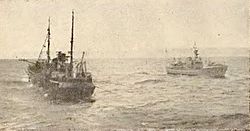
Coventry City and ICGV Albert off the WestfjordsDate 1 September – 12 November 1958 Location Waters surrounding Iceland Result An agreement is reached between the United Kingdom and Iceland where the UK accept the Icelandic annexation while Iceland agrees to take further claims before the International court at Hague. Territorial
changesIceland expands its territorial waters to 12 nautical miles Belligerents  Iceland
Iceland United Kingdom
United KingdomCommanders and leaders  Hermann Jónasson
Hermann Jónasson
 Bjarni Benediktsson
Bjarni Benediktsson
 Capt. Pétur Sigurðsson
Capt. Pétur Sigurðsson
 Capt. Eiríkur Kristófersson
Capt. Eiríkur Kristófersson Harold Macmillan
Harold Macmillan
 Lord Carrington
Lord Carrington
 Cdre Anderson
Cdre AndersonStrength  Icelandic Coast Guard
Icelandic Coast Guard
2 large Patrol vessels (3 in Feb. 1960)
6 small Patrol vessels Royal Navy
Royal Navy
28 Destroyers
32 Frigates
1 Fast Minelayer
1 Minesweeper
10 RFA Supply vesselsThe First Cod War
The First Cod War lasted from 1 September until 12 November 1958. It began as soon as a new Icelandic law that expanded the Icelandic fishery zone from 4 nautical miles (nmi) to 12 nmi (from 7.4 to 22.2 km), came into force at midnight of 1 September.
The British declared that their trawlers would fish under protection from their warships in three areas, out of the Westfjords, north of Horn and to the southeast of Iceland. All in all, 20 British trawlers, 4 warships and a supply vessel were inside the newly declared zones. This deployment was expensive, in February 1960 Lord Carrington, the minister responsible of the Royal Navy, reported that his ships near Iceland had expended half a million pounds sterling worth of oil since the new year and that a total of 53 British warships had taken part in the operations.[3] Against this Iceland could deploy seven Patrol vessels[4] and a single PBY-6A Catalina flying boat.[5]
Many incidents followed, such as the one on 4 September, when the V/s Ægir, an Icelandic patrol vessel, attempted to take a British trawler off the Vestfjords, but was thwarted when HMS Russell intervened, and the two vessels collided.
On 6 October, V/s María Júlía fired three shots at the trawler Kingston Emerald, forcing the trawler to escape to sea.
On 12 November, V/s Þór encountered the trawler Hackness which had not stowed its nets legally. Hackness did not stop until Þór had fired two blanks and one live shell off its bow. Once again, HMS Russell came to the rescue and its shipmaster ordered the Icelandic captain to leave the trawler alone as it was not within the 4 nmi (7.4 km) limit recognised by the British government. Þór's captain, Eiríkur Kristófersson, said that he would not do so, and ordered his men to approach the trawler with the gun manned. In response, the Russell threatened to sink the Icelandic boat if it so much as fired one shot at the Hackness. More British ships then arrived and the Hackness escaped.
Eventually Britain and Iceland came to a settlement, which stipulated that any future disagreement between Iceland and Britain in the matter of fishery zones would be sent to the International Court of Justice in the Hague.
The Second Cod War
Second Cod War Part of the Cod Wars 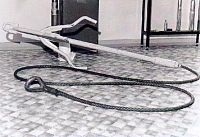
A net cutter, first used in the Second Cod War.Date 1 September 1972 – 8 November 1973 Location Waters surrounding Iceland Result An agreement is reached between the United Kingdom and Iceland where the UK accept the Icelandic annexation in exchange for permission to catch 150,000 tons of fish until 1975. Territorial
changesIceland creates 50 nautical mile exclusive fishery zone Belligerents  Iceland
Iceland United Kingdom
United Kingdom
 West Germany
West GermanyCommanders and leaders  Ólafur Jóhannesson
Ólafur Jóhannesson
 Capt. Pétur Sigurðsson
Capt. Pétur Sigurðsson
 Cdr. Guðmundur Kjærnested
Cdr. Guðmundur Kjærnested
 Cdr. Helgi Hallvarðsson
Cdr. Helgi Hallvarðsson Edward Heath
Edward Heath
Strength  Icelandic Coast Guard
Icelandic Coast Guard
3 large Patrol vessels
2 small Patrol vessels
1 Armed Whaler Royal Navy
Royal Navy
30 Frigates
1 Destroyer
11 RFA Supply vessels
 Ministry of Agriculture, Fisheries and Food
Ministry of Agriculture, Fisheries and Food
5 Defence TugsOn 1 September 1972, the enforcement of the law that expanded the Icelandic fishery limits to 50 nm (92.6 km) began. Numerous British and West German trawlers continued fishing within the new zone on the first day. The Icelandic leftist coalition which governed at the time ignored the treaty that stipulated the involvement of the International Court of Justice and said that it wasn't bound by agreements made by the previous centre-right government.
The next day, the ICGV Ægir chased 16 trawlers in waters east of the country, out of the 50 nmi (93 km) zone.
During this war, the Icelandic Coast Guard started to use net cutters to cut the trawling lines of non-Icelandic vessels fishing within the new exclusion zone. On 18 January 1973, the nets of eighteen trawlers were cut. This forced the British seamen to threaten to leave the Icelandic fishery zone unless they had the protection of the Royal Navy. The day after, large, fast tugboats were sent to their defence. The first was the Statesman. The British considered this insufficient, and formed a special group to defend the trawlers.
On 23 January 1973, the volcano Eldfell on Heimaey erupted and the Coast Guard needed to divert its attention to rescuing the inhabitants of the small island.
On 17 May, the British trawlers left the Icelandic waters, only to return two days later along with British frigates. The Icelandic Lighthouse tender ICGV Árvakur collided with four British vessels on 1 June and six days later V/s Ægir collided with HMS Scylla, when it was reconnoitering for icebergs off the Vestfjords, even though no trawlers were present.
On 16 September, Joseph Luns, Secretary-General of NATO, arrived in Reykjavík to talk with Icelandic ministers, who had been pressed to leave NATO as it had been of no help to the Icelandic people in the conflict. (Britain and Iceland both being members, the Royal Navy made use of Icelandic bases in the cold war as part of its primary NATO duty of guard of the Greenland-Iceland-UK gap, particularly against Soviet submarines.)
After a series of talks within NATO, British warships were recalled on 3 October. An agreement was signed on 8 November which limited British fishing activities to certain areas inside the 50 nmi (93 km) limit, resolving the dispute that time. The resolution was based on the premise that British trawlers would limit their annual catch to no more than 130,000 tons. This agreement expired in November 1975, and the third "Cod War" began.
C.S.Forester incident
On 19 July 1974[6] more than nine months after the signing of the agreement, one of the largest wet fish stern trawlers in the British Fleet, C.S. Forester,[7] which had been fishing inside the 12-nautical-mile limit was shelled and captured by the Icelandic gunboat V/s Þór after a 100-mile pursuit.[8] C. S. Forester was shelled with non-explosive ammunition after repeated warnings. The trawler was hit by at least two rounds, which damaged the engine room and a water tank.[9] She was later boarded and towed to Iceland.[10] Skipper Richard Taylor was condemned to 30 days of imprisonment and fined £5000. He was released on bail after the owners paid £2232. The trawler was also allowed to depart with a cache of 200 tons of fish. Her owners paid a total of £26300 for the release of the ship.[8]
The Third Cod War
Third Cod War Part of the Cod Wars 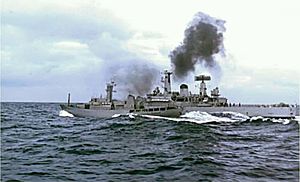
Icelandic gunboat Odinn and British frigate HMS Scylla clash in the North AtlanticDate 16 November 1975 – late June 1976 Location Waters surrounding Iceland Result An agreement is reached between the United Kingdom and Iceland where the UK accept the expansion while receiving a temporary allowable catch for its fishing fleet. Territorial
changesIceland expands its exclusive fishery zone to 200 nautical miles Belligerents  Iceland
Iceland United Kingdom
United KingdomCommanders and leaders  Geir Hallgrímsson
Geir Hallgrímsson
 Capt.Pétur Sigurðsson
Capt.Pétur Sigurðsson
 Cdr. Guðmundur Kjærnested
Cdr. Guðmundur Kjærnested
 Cdr. Helgi Hallvarðsson
Cdr. Helgi Hallvarðsson Harold Wilson
Harold Wilson
Strength  Icelandic Coast Guard
Icelandic Coast Guard
4 large Patrol vessels
2 small Patrol vessels
2 Armed Trawlers Royal Navy
Royal Navy
22 Frigates
7 RFA Supply vessels
 Ministry of Agriculture, Fisheries and Food
Ministry of Agriculture, Fisheries and Food
6 Defence TugsThe Third Cod War (November 1975 – June 1976) occurred between the United Kingdom and Iceland. Iceland had declared that the ocean up to 200 nautical miles (370 km) from its coast fell under Icelandic authority. The British government did not recognise this large increase to the exclusion zone, and as a result, there came to be an issue with British fishermen and their 'incursion' into the disputed zone. The 'war', which was the most hard fought of the Cod Wars, saw British fishing trawlers have their nets cut by the Icelandic Coast Guard, and there were several incidents of ramming by Icelandic ships and British trawlers, frigates and tugboats.
One of the more serious incidents occurred on 11 December 1975. As reported by Iceland, V/s Þór, under the command of Helgi Hallvarðsson, was leaving port at Seyðisfjörður, where it had been minesweeping, when orders were received to investigate the presence of unidentified foreign vessels at the mouth of the fjord. These vessels were identified as three British ships, Lloydsman, an ocean going tug which was three times bigger than V/s Þór, Star Aquarius, an oil rig supply vessel of British Ministry of Agriculture, Fisheries and Food, and her sister ship Star Polaris. They were sheltering from a force nine gale within Iceland's 12-nautical-mile (22 km) territorial waters.[11]
In the Icelandic account, when ordered to leave Icelandic territorial waters by Þór´s commander the three tugboats initially complied. But around two nautical miles (4 km) from the coast the Star Aquarius allegedly veered to starboard and hit Þór´s port side as the Coast Guards attempted to overtake the Star Aquarius . Even as Þór increased speed, the Lloydsman again collided with its port side. The Þór had suffered considerable damage by these hits so when the Star Aquarius came about, a blank round was fired from Þór. This didn't deter the Star Aquarius as it hit Þór a second time. Another shot was fired from Þór as a result, this time a live round that hit Star Aquarius's bow. After that the tug-boats retreated. V/s Þór, which was close to sinking after the confrontation, sailed to Loðmundarfjörður for temporary repairs.[12]
The British reports of the incident differ considerably, maintaining that Þór attempted to board one of the tug-boats, and as Þór broke away the Lloydsman surged forward to protect the Star Aquarius. Captain Albert MacKenzie of the Star Aquarius said the Þór approached from the stern and hit the support vessel before it veered off and fired a shot from a range of about 100 yards (91 m). Niels Sigurdsson, the Icelandic Ambassador in London, said Þór had been firing in self-defence after it had been rammed by British vessels. Iceland consulted the United Nations Security Council over the incident, which declined to intervene.[13]
A second incident occurred in January 1976, when HMS Andromeda collided with the Þór. Þór sustained a hole in its hull, while the Andromeda's hull was dented. The British Ministry of Defence said that the collision represented a "deliberate attack" on the British warship "without regard for life". The Icelandic Coast Guard on the other hand insisted Andromeda had rammed Þór by "overtaking the boat and then swiftly changing course".[citation needed]
Britain deployed a total of 22 frigates. In addition to the frigates, the British also deployed a total of seven supply ships, nine tug-boats, and three support ships to protect its fishing trawlers, although only six to nine of these vessels were on deployment at any one time.[14] Iceland deployed four patrol vessels (V/s Óðinn, V/s Þór, V/s Týr, and V/s Ægir) and two armed trawlers (V/s Baldur and V/s Ver).[15][14] The Icelandic government tried to acquire U.S. Asheville class gunboats, and when denied by the American government they tried to get Soviet Mirka class frigates. A more serious turn of events came when Iceland threatened closure of the NATO base at Keflavík, which would have severely impaired NATO's ability to defend the Atlantic Ocean from the Soviet Union. As a result, the British government agreed to have its fishermen stay outside Iceland's 200 nautical mile (370 km) exclusion zone without a specific agreement.
On the evening of 6 May 1976, after the outcome of the Third Cod War had already been decided, the V/s Týr was trying to cut the nets of the trawler Carlisle, when Captain Gerald Plumer of the HMS Falmouth ordered it rammed. The Falmouth at the speed of 22+ knots (41+ km/h) rammed the Týr, almost capsizing her. The Týrdid not sink and managed to cut the nets of Carlisle, after which the Falmouth rammed it again. The Týr was heavily damaged and propelled by only a single screw and pursued by the tug-boat Statesman. In this dire situation, Captain Guðmundur Kjærnested gave orders to man the guns, in spite of the overwhelming superiority of firepower the Falmouth enjoyed, to deter any further rammings. [16]
Results
Iceland achieved its overall aims, to the detriment of the already declining British fisheries due to their own overfishing,[17] severely affecting the economies of northern fishing ports in the UK, such as Grimsby, Hull and Fleetwood.[18]
See also
- Overfishing
- Exclusive Economic Zone
- International waters
- British military history
- Spanish ships and the Canadian Navy had clashes over fishing in the 1990s in what was known in the Spanish press as la guerra del fletán, the Turbot War
- Iceland – United Kingdom relations
References
- ^ The Icelandic Coast Guard's name in Icelandic directly translates as "Territorial waters Guard".
- ^ Útfærsla efnahagslögsögunnar
- ^ Sveinn Sæmundsson, Guðmundur skipherra Kjærnested, Örn og Örlygur. [Reykjavík]. 1984. p. 151.
- ^ Jón Björnsson, Íslensk skip. vol. III. Reykjavik. 1990 p. 8-142 ISBN 9979103752
- ^ Svipmyndir úr 70 ára sögu. Landhelgisgæsla Íslands. Reykjavík. 1996. pp. 30-31, 37–38. ISBN 9979602775
- ^ Jessup, John E. (1998).An encyclopedic dictionary of conflict and conflict resolution, 1945-1996. Greenwood Publishing Group, p. 130. ISBN 0313281122
- ^ Fishing news international, V. 14, nº 7-12. A. J. Heighway Publications., 1975
- ^ a b C S Forester H86
- ^ Commons debate, 29 July 1974
- ^ The Illustrated London news, V. 262, nº 2. The Illustrated London News & Sketch Ltd., 1974
- ^ Storey, Norman, What price cod? : a tugmaster's view of the cod wars. Beverley, North Humberside. Hutton Press. c 1992. ISBN 1872167446
- ^ Atli Magnússon, Í kröppum sjó : Helgi Hallvarðsson skipherra segir frá sægörpum og svaðilförum. Örn og Örlygur. [Reykjavík]. 1992. p. 204-206 ISBN 997955035X Ib. :
- ^ Guðni Thorlacius Jóhannesson, Þorskastríðin þrjú : saga landhelgismálsins 1948–1976, Hafréttarstofnun Íslands. Reykjavík. 2006. ISBN 9979701412 (ib.)
- ^ a b Jane's fighting ships : the standard reference of the world's navies. London, [1900– ].
- ^ Atli Magnússon, Í kröppum sjó : Helgi Hallvarðsson skipherra segir frá sægörpum og svaðilförum. Örn og Örlygur. [Reykjavík]. 1992. p. 201-202
- ^ Óttar Sveinsson, Útkall : Týr er að sökkva. Útkall. [Reykjavík] 2004. ISBN 9979956968 (ib.)
- ^ Georg H. Engelhard One hundred and twenty years of change in fishing power of English North Sea trawlers, in Advances in fisheries science: 50 years on from Beverton and Holt (Ed.) Andy Payne, John Cotter, Ted Potter, John Wiley and Sons, 2008, ISBN 1405170832, p. 1 doi:10.1002/9781444302653.ch1, mirror
- ^ Teed, Peter: The Dictionary of Twentieth Century History, 1914–1990. Oxford University Press, 1992. Page 95. ISBN 0192116762
Further reading
- Ingo Heidbrink: “Deutschlands einzige Kolonie ist das Meer” Die deutsche Hochseefischerei und die Fischereikonflikte des 20. Jahrhunderts. Hamburg (Convent Vlg) 2004.
- Kurlansky, Mark. Cod: A Biography of the Fish That Changed the World. New York: Walker & Company, 1997 (reprint edition: Penguin, 1998). ISBN 0-8027-1326-2, ISBN 0-14-027501-0.
External links
- American University Case Study – The Cod War
- MV Miranda Site Website of the MV Miranda, a Trawler support vessel
- Britain's Small Wars – The Cod War
- BBC Video footage from the BBC (Requires Realplayer)
- Fiskveiðideilur Íslendinga við erlendar þjóðir, by Guðni Jóhannesson (Icelandic)
- BBC 'On this Day' 1973: Royal Navy moves to protect trawlers
- BBC 'On this Day' 1975: "Attack on British vessels heightens Cod War"
United Kingdom topics Geography Administrative Physical Lakes and lochs · Mountains · Rivers · Volcanoes · Great Britain · Geology of Great Britain · Geology of Northern Ireland
History Maritime · Economic · Military · British Empire · Timeline
Politics · Government Economy Pound sterling · London Stock Exchange · Banks (Bank of England) · Taxation · Transport · Communications · Economic geography · Mining · Energy · Budget
Military Society · Demography Cities · Crime · Ethnic groups · Immigration · Languages · Poverty · Social structure · Towns
Culture Art · Cinema · Cuisine · Identity · Literature · Media · Music · Sport · Television · Theatre · Public holidays
England Northern Ireland Scotland Wales History · Welsh Government · Welsh Assembly · First Minister · Politics · Education · Health care · Religion · Tourism
 Category ·
Category ·  Portal ·
Portal ·  WikiProject
WikiProjectHistory of fishing History - History of fishing
- Traditional fishing boats
- Chasse-marée
- Cornwall
- Scottish east coast fishery
- Garum
- Ancient Hawaiian aquaculture
- Migratory Fishery of Labrador
- Munster pilchard fishery 1570-1750
- Fishery Protection Squadron
- Cod-fishing in the North atlantic
- Pearling in WA
- Scania Market
- Harold Innis and the cod fishery
- Fishing stage
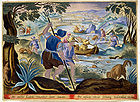
Conflicts Disasters Historic fishing villages and communities Fishing villages - Akwidaa
- Algajola
- Ardglass
- Bethsaida
- Bolungarvík
- Cadgwith
- Catalan Bay
- Clovelly
- Cullercoats
- Dunmore East
- Findon
- Gilleleje
- Grip
- Gümüşlük
- Hovden
- Huanchaco
- Kaunolu Village
- Ladner
- Lamorna
- Marsaxlokk
- Moskenes
- Newhaven
- Nyksund
- Old Perlican
- Ona
- Peggys Cove
- Pittenweem
- Po Toi O
- Polperro
- Port Isaac
- Portmahomack
- Portavogie
- Portofino
- St. Abbs
- Red Bay
- Reine
- Saint Malo
- Sa Riera
- Sayulita
- Sigri
- Staithes
- Steveston
- Súðavík
- Suðureyri
- Tai O
- Tilting
- Udappu
- Vernazza
- Walraversijde
- more...

Communities - Fishing
- Index of fishing articles
- List of fishing topics by subject
- Fisheries glossary
Categories:- 20th-century conflicts
- Foreign relations of Iceland
- History of Iceland
- Fishing in Iceland
- Law of the sea
- Icelandic Coast Guard
- 20th-century military history of the United Kingdom
- Fishing law
- Wars involving Iceland
- History of fishing
- Fishing in the United Kingdom
- Fishing in Scotland
- 1950s in the United Kingdom
- 1970s in the United Kingdom
- Battles and conflicts without fatalities
- Maritime incidents in 1958
- Maritime incidents in 1972
- Maritime incidents in 1973
- Maritime incidents in 1974
- Maritime incidents in 1975
- Maritime incidents in 1976
- Wars involving the United Kingdom
- Trade wars
Wikimedia Foundation. 2010.



